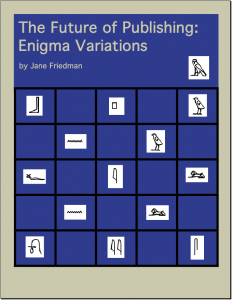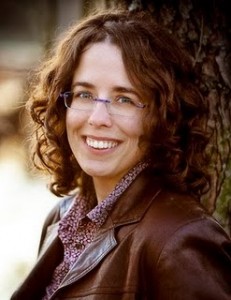 While we were attending the Association of Writers and Writing Programs Conference earlier this year, I challenged Jane Friedman to write a book on the future of publishing. Much to my surprise, she took me up on it.
While we were attending the Association of Writers and Writing Programs Conference earlier this year, I challenged Jane Friedman to write a book on the future of publishing. Much to my surprise, she took me up on it.
On April Fool’s Eve, I posted an interview with Jane just prior to the unveiling of “The Future of Publishing: Enigma Variations” on April Fool’s Day.
I thought readers would be interested in hearing first-hand what it’s like to self-publish a short, smart, humor e-book, so I asked Jane for another interview this time with a behind-the-scenes look at the e-book creation process. I hope you enjoy it.
Christina Katz: Okay, so I challenged you to write an e-book and you agreed. Why in the world did you say, “Yes”?
Jane Friedman: Ha! My first thought was: No one cares what I think about the future of publishing, and I’m personally and professionally tired of speculation.
But then it occurred to me that I might have fun with the topic. I do know the issues inside and out, so once I decided to engage in a little satire, I got excited about the idea.
I also came up with a strict framework. Having a structure to play off of was important to idea generation and my enthusiasm. In this case, the framework was “14 variations on the future,” inspired by Elgar’s work, “Enigma Variations.”
I was also curious to see if an online (and real world) following would translate into people who’d pay money to read my writing. At this point, people can read most of my advice online for free. They may have to pay to hear me speak, but the writing itself is delivered free of charge, with the exception of the Beginning Writers’ Answer Book from 2006.
Christina Katz: But writing an e-book that is high-enough quality to charge money for is not an easy undertaking. You must have had some concerns at the outset. Would you be willing to share some of them?
Jane Friedman: Yes, I had 3 primary concerns.
1. Even if by reading the entire work you had a better understanding of the issues at play in the publishing industry, I was still writing humor. Humor is not something people often pay for, no matter how high quality it is.
2. People will pay good money for information that benefits them. But they rarely pay for speculation—at least in the publishing field! And since I was writing about the future of publishing, what else could my e-book be called except pure speculation?
3. I knew the work would be quite short, especially given the fast turn-around time. It ended up being 40 pages, and that’s with images and a generous design. (Still, though, it probably takes 20-30 minutes to read.)
Christina Katz: How many folks helped you with the e-book production process and what roles did they play?
Jane Friedman: The only help I needed was editing. I had two very good friends—who I later treated to a celebratory launch-day dinner!—help me with the content development, punch lines, and line editing. I did the design and production work myself, which was not difficult. I’ve been doing that kind of work for 15 years.
Christina Katz: Can you give us a quick thumbnail overview of the phases you had to take the e-book through to go from zero to published in just a couple of short months?
Jane Friedman: This is how I’d describe the stages:
- Inspiration and planning stage. I came up with the structure and started outlining what I would write.
- Draft stage. In one sitting, I wrote the entire work longhand. (Not typical for me, but that’s how it worked out.)
- Revision stage. When I typed out my longhand manuscript, I also revised and added content as I went.
- Editing stage. I sent my manuscript to two trusted friends (who are also editors, yay!), who turned it around in less than a week.
- Production stage. While my friends edited the manuscript, I set up the design templates and created the front and back matter. I also created the images at this stage.
- Final production stage. After I had all the edits back, I incorporated them into the final manuscript, dumped the copy into my design template, and took care of all layout/design issues. Then I proofread a printed copy with a friend in one evening, made final corrections in the file, and outputted a PDF that I made available for sale within minutes on Scribd.
Christina Katz: Which part of the e-book creation process was your favorite? Which part was your least favorite?
Jane Friedman: The transition from production stage to final production stage was nerve-wracking. I had a deadline to meet that wasn’t negotiable in my mind (April Fool’s Day), but I was depending on the good graces of my friends to serve as editors (for free), and I was reluctant to start selling without their feedback. Lucky for me, they finished up in time to go live April 1.
My favorite part—as it is with every project—was the idea generation stage. I love coming up with the premise and structure. Ideas are always lovely. Once you make them concrete, you have to struggle through making them live up to the ideal that’s in your head.
Christina Katz: You are pretty tech-savvy, which technologies did you make use of to create the e-book and how user-friendly were they?
Jane Friedman: I used Adobe InDesign to design and layout the book, and to export the PDF file. InDesign is a program that I used for many years while working in traditional publishing, so there was no learning curve. But it’s expensive software for a writer to buy, and not easy to learn without formal instruction.
I used no other technology to create the e-book, aside from taking pictures with my iPhone and adjusting them in Apple’s Preview, a very elementary photo-editing software.
Christina Katz: Any pros vs. cons to approaching the short-form e-book vs. the long-form book? Which do you think you prefer?
Jane Friedman: I don’t think I prefer either at this point, speaking as an author.
However …
Projects that extend over a period of many months or years do have a tendency to get boring for me. It’s probably why I’ve stuck with blogging for so long. It’s fast-paced, there’s lots of fun and value in it, it gives me a writing outlet, but I don’t have to keep revisiting the same material again and again. I get to vary the topics/issues and suit some of my own whims.
On the other hand, I like building things of solid quality and substance. And a long-form book does that. So I still look forward to those projects as well—it just requires me to be disciplined and passionate about what I take on.
Christina Katz: Are you hooked? Will you write more e-books? Or will you be too busy following through with this one for a while?
Jane Friedman: This e-book project gave me a tight deadline, and it kept my interest. And while I’ll spend a bit more time nurturing it—producing a Kindle edition, for instance—I consider myself through.
I am indeed considering what new e-book project might be next. I’m sure I’ll attempt another, but something more information-driven—not humor or speculation.
Probably the No. 1 topic that I’m asked about is online and social media. So perhaps I’ll do a full-length e-book addressing that. That said, if I’m contracted to write a long-form book for Writer’s Digest, all bets are off.
As the former publisher and editorial director of Writer’s Digest, Jane Friedman is an industry authority on commercial, literary, and emerging forms of publishing. She has spoken at more than 200 writing events since 2001, and is known within the publishing industry as an innovator, cited by sources such as Publishers Weekly, GalleyCat, PBS, and Mr. Media. She has been a speaker at BookExpo America, an adviser to Digital Book World, and recently served as a panelist for the National Endowment for the Arts, to review 2011 grants in literature.

Comments on this entry are closed.
Thanks for such an excellent set of questions to respond to! 🙂